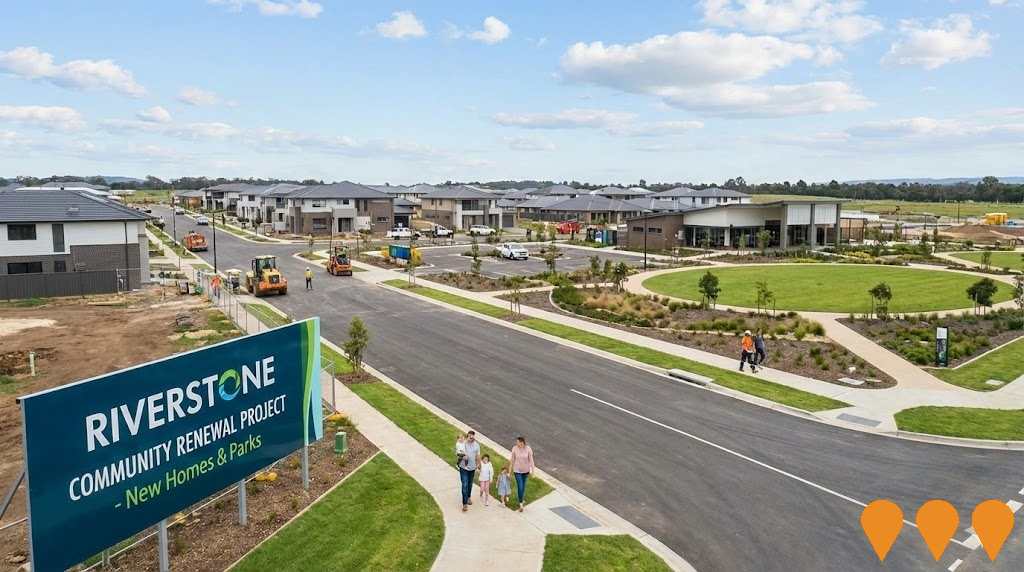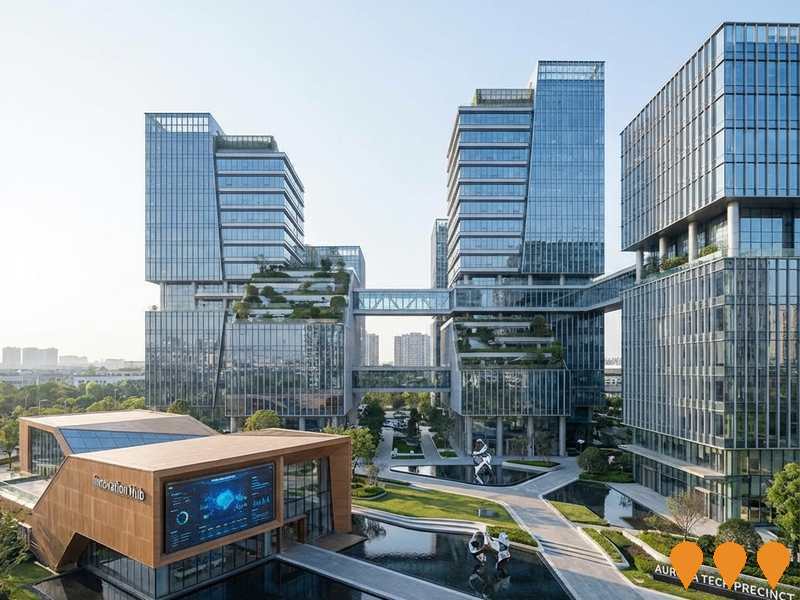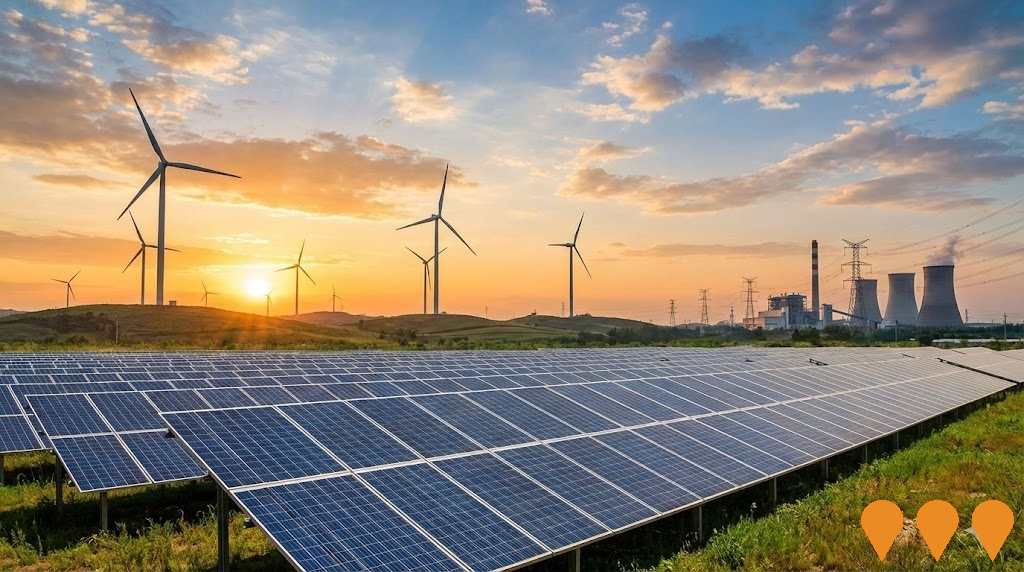Chart Color Schemes
est. as @ -- *
ABS ERP | -- people | --
2021 Census | -- people
Sales Activity
Curious about local property values? Filter the chart to assess the volume and appreciation (including resales) trends and regional comparisons, or scroll to the map below view this information at an individual property level.
Find a Recent Sale
Sales Detail
Population
Cranbourne West lies within the top 10% of areas nationally in terms of population growth performance according to AreaSearch analysis of short and medium-term trends
Cranbourne West's population was around 25,218 as of August 2025, reflecting an increase of 3,683 people since the 2021 Census. The ABS estimated resident population in June 2024 was 24,908, with an additional 486 validated new addresses since the Census date contributing to this growth. This results in a population density of 1,954 persons per square kilometer, higher than the average across national locations assessed by AreaSearch. Cranbourne West's growth rate of 17.1% since the 2021 census exceeded both the national average (8.6%) and state averages, positioning it as a growth leader in the region. Natural growth contributed approximately 38.2% to overall population gains during recent periods, with all drivers including interstate migration and overseas migration being positive factors. AreaSearch adopts ABS/Geoscience Australia projections for each SA2 area released in 2024 using 2022 as the base year.
For areas not covered by this data, AreaSearch utilises VIC State Government's Regional/LGA projections released in 2023 with adjustments made employing a method of weighted aggregation of population growth from LGA to SA2 levels. Growth rates by age group are applied across all areas for years 2032 to 2041. Future population dynamics anticipate exceptional growth, placing Cranbourne West in the top 10 percent of statistical areas nationally, with an expected increase of 13,856 persons by 2041 based on latest population numbers, resulting in a total increase of 53.7% over the 17-year period.
Frequently Asked Questions - Population
Development
The level of residential development activity in Cranbourne West was found to be higher than 90% of real estate markets across the country
Cranbourne West has recorded approximately 276 residential properties granted approval annually. Over the past five financial years, from FY-21 to FY-25, a total of 1,381 homes were approved, with an additional 35 approved in FY-26. On average, 3.7 people have moved to the area per dwelling built over these five years.
This supply lagging behind demand typically results in heightened buyer competition and pricing pressures. The average construction cost of new homes is $437,000, aligning with broader regional development trends. In FY-26, there have been $114.7 million in commercial approvals, indicating robust local business investment. Compared to Greater Melbourne, Cranbourne West has 14.0% less new development per person but ranks among the 59th percentile of areas assessed nationally, suggesting strong developer confidence. New development consists of 55.0% detached houses and 45.0% townhouses or apartments, marking a shift from the area's existing housing composition (currently 83.0% houses).
With around 254 people per dwelling approval, Cranbourne West indicates a developing market. By 2041, the area is expected to grow by approximately 13,540 residents. Construction pace is maintaining with projected growth; however, buyers may face growing competition as population increases.
Frequently Asked Questions - Development
Infrastructure
Cranbourne West has moderate levels of nearby infrastructure activity, ranking in the top 50% nationally
Changes to local infrastructure significantly influence an area's performance. AreaSearch has identified 35 projects likely to impact the area. Notable projects include Cranbourne West Distribution Centre, ESR Greenlink Industrial Estate, RISE, Hall Road, Cranbourne West, and Harli. The following list details those expected to be most relevant.
Professional plan users can use the search below to filter and access additional projects.
INFRASTRUCTURE SEARCH
 Denotes AI-based impression for illustrative purposes only, not to be taken as definitive under any circumstances. Please follow links and conduct other investigations from the project's source for actual imagery. Developers and project owners wishing us to use original imagery please Contact Us and we will do so.
Denotes AI-based impression for illustrative purposes only, not to be taken as definitive under any circumstances. Please follow links and conduct other investigations from the project's source for actual imagery. Developers and project owners wishing us to use original imagery please Contact Us and we will do so.
Frequently Asked Questions - Infrastructure
Casey Central Town Centre Development
A comprehensive 60-hectare town centre development approved to create a vibrant mixed-use precinct. Anchored by the existing Casey Central Shopping Centre, the project is set to deliver approximately 1,850 new homes, 4,100 jobs, and significant community infrastructure including a new town square, integrated community facilities, and upgraded transport links.

Cranbourne Community Hub
A new integrated community services hub in central Cranbourne that brings together council customer services, Connected Libraries (Cranbourne Library), youth services, community legal centre, maternal and child health, and community support services in one modern facility to improve access and community connectivity.

Cranbourne West Secondary College
New secondary college serving growing Cranbourne West community. Modern facilities including science labs, performing arts spaces, sports facilities, and technology-enabled learning environments. Capacity for 1,200 students from Years 7-12.

ESR Greenlink Industrial Estate
A 79-hectare industry-leading industrial estate in Melbourne's south-east, featuring sustainable facilities with 5 & 6 Star Green Star ratings, parkland, walking tracks, landscaping, and recreational spaces. Home to major logistics operators including Amazon, CEVA Logistics, Focus on Furniture, JAS Worldwide, and TW Logistics.

Lyndhurst Inland Port and Industrial Hub
Major industrial development including freight terminal, warehouse and distribution facilities. Strategic inland port location with development plans approved by Greater Dandenong Council, connecting to major transport networks for efficient freight movement to regional areas and ports. The project, also known as Dandenong South Intermodal Terminal, features a fully automated 24-hour operation with rail connections to the Port of Melbourne, aimed at reducing truck congestion and emissions.

Cranbourne West Distribution Centre
A state-of-the-art distribution centre in Melbourne's south-east premium logistics hub. The 6.2-hectare estate comprises two stages, with Stage 1 (Warehouses 1A and 1B) completed and fully leased in 2023. Warehouse 2 is a standalone 20,986sqm facility featuring ultra-high clearance warehouse space (10.6m-14.2m), dual-level corporate offices, ESFR sprinklers, and extensive hardstand areas. Available from October 2025.

Cranbourne West Community Hub
A state-of-the-art dual-level community facility featuring welcoming spaces for programs, services, and activities. Includes community halls with capacity up to 180 people, commercial kitchen, courtyards, meeting rooms, training spaces, wellbeing areas, and functional rooftop. The hub houses Connected Libraries Cranbourne West Library Lounge (opened January 2024), multiple community service organizations including OC Connections Casey Disability Support Hub, AMES Australia services for migrants and refugees, and various community programs. Offers fitness classes, dance, yoga, art programs, school holiday activities, employment support, legal assistance, and cultural networking groups.

Harli
Harli is a 7 Star, all-electric, zero-carbon master planned community in Cranbourne West by Resolution Property Group. The project delivers 181 residential lots with a 2 hectare wetland, staged civil works (Stages 1 and 2 titled in 2024) and final stages targeting titles in Q1 2026.

Employment
Cranbourne West has seen below average employment performance when compared to national benchmarks
Cranbourne West has a skilled workforce with strong representation in manufacturing and industrial sectors. The unemployment rate was 5.0% as of June 2025, which is 0.4% higher than Greater Melbourne's rate of 4.6%.
Employment growth over the past year was estimated at 3.7%. There are 13,077 residents in work, with a workforce participation rate of 69.8%, compared to Greater Melbourne's 64.1%. The dominant employment sectors among residents include health care & social assistance, manufacturing, and construction. Manufacturing is particularly specialized, employing 1.8 times the regional level.
However, professional & technical services employ only 4.4% of local workers, below Greater Melbourne's 10.1%. Over the year to June 2025, employment increased by 3.7%, while labour force grew by 4.4%, resulting in a rise in unemployment by 0.6 percentage points. Jobs and Skills Australia forecasts national employment growth of 6.6% over five years and 13.7% over ten years. Applying these projections to Cranbourne West's employment mix suggests local growth of approximately 6.2% over five years and 13.2% over ten years.
Frequently Asked Questions - Employment
Income
The economic profile demonstrates above-average performance, with income metrics exceeding national benchmarks based on AreaSearch comparative assessment
Cranbourne West had a median taxpayer income of $54,632 and an average of $61,935 according to the latest postcode level ATO data aggregated by AreaSearch for financial year 2022. This is lower than national averages, with Greater Melbourne's median income being $54,892 and average income being $73,761. Based on Wage Price Index growth of 12.16% since financial year 2022, estimated incomes as of September 2025 would be approximately $61,275 (median) and $69,466 (average). Census data shows that incomes in Cranbourne West cluster around the 58th percentile nationally. The income distribution reveals that the $1,500 - 2,999 bracket dominates with 45.2% of residents (11,398 people), similar to the metropolitan region where this cohort represents 32.8%. High housing costs consume 19.0% of income, but strong earnings place disposable income at the 56th percentile nationally. The area's SEIFA income ranking places it in the 4th decile.
Frequently Asked Questions - Income
Housing
Cranbourne West is characterized by a predominantly suburban housing profile, with ownership patterns similar to the broader region
Cranbourne West's dwelling structures, as per the latest Census, consisted of 83.2% houses and 16.8% other dwellings (semi-detached, apartments, 'other' dwellings). This compares to Melbourne metro's 91.5% houses and 8.5% other dwellings. Home ownership in Cranbourne West stood at 12.5%, with mortgaged dwellings at 65.3% and rented ones at 22.2%. The median monthly mortgage repayment was $1,842, lower than Melbourne metro's $1,950. Median weekly rent was $380, similar to Melbourne metro's $386. Nationally, Cranbourne West's mortgage repayments were lower ($1,842 vs $1,863), while rents were higher ($380 vs $375).
Frequently Asked Questions - Housing
Household Composition
Cranbourne West features high concentrations of family households, with a lower-than-average median household size
Family households constitute 83.0% of all households, including 48.0% couples with children, 20.6% couples without children, and 13.0% single parent families. Non-family households comprise the remaining 17.0%, with lone person households at 14.8% and group households making up 2.3% of the total. The median household size is 3.1 people, which is smaller than the Greater Melbourne average of 3.2.
Frequently Asked Questions - Households
Local Schools & Education
Cranbourne West performs slightly above the national average for education, showing competitive qualification levels and steady academic outcomes
Cranbourne West faces educational challenges, with university qualification rates at 23.5%, significantly lower than Greater Melbourne's average of 37.0%. This presents both a challenge and an opportunity for targeted educational initiatives. Bachelor degrees are the most common, at 16.1%, followed by postgraduate qualifications (5.4%) and graduate diplomas (2.0%). Vocational credentials are prevalent, with 37.4% of residents aged 15+ holding them, including advanced diplomas (13.9%) and certificates (23.5%).
Educational participation is high, at 33.0%, comprising primary education (13.0%), secondary education (7.2%), and tertiary education (3.9%). The area's four schools have a combined enrollment of 4,662 students as of the latest data. These schools operate under typical Australian school conditions, with an ICSEA score of 1012, indicating balanced educational opportunities. Educational provision is conventional, split between two primary and two secondary institutions.
Frequently Asked Questions - Education
Schools Detail
Nearby Services & Amenities
Transport
Transport servicing is moderate compared to other areas nationally based on assessment of service frequency, route connectivity and accessibility
Cranbourne West has 45 active public transport stops, all of which are bus stops. These stops are served by 7 different routes that together facilitate 2,289 weekly passenger trips. The area's transport accessibility is rated as good, with residents typically located 302 meters from the nearest transport stop.
On average, there are 327 trips per day across all routes, which translates to approximately 50 weekly trips per individual stop.
Frequently Asked Questions - Transport
Transport Stops Detail
Health
Cranbourne West's residents boast exceedingly positive health performance metrics with younger cohorts in particular seeing very low prevalence of common health conditions
Cranbourne West shows excellent health outcomes, particularly for younger age groups who have a very low prevalence of common health conditions.
Approximately 51% (~12,760 people) of residents have private health cover, which is relatively low. The most prevalent medical conditions are asthma and mental health issues, affecting 7.6% and 6.9% of residents respectively. A total of 76.4% of residents report no medical ailments, comparable to Greater Melbourne's 76.4%. Cranbourne West has a lower proportion of seniors aged 65 and over at 8.5% (2,138 people) compared to Greater Melbourne's 9.6%. However, health outcomes for seniors require more attention than the broader population.
Frequently Asked Questions - Health
Cultural Diversity
Cranbourne West is among the most culturally diverse areas in the country based on AreaSearch assessment of a range of language and cultural background related metrics
Cranbourne West has a high cultural diversity with 43.0% of its population born overseas and 44.7% speaking a language other than English at home. Christianity is the predominant religion, accounting for 36.4% of people in Cranbourne West. The 'Other' category shows an overrepresentation at 9.0%, compared to Greater Melbourne's 6.5%.
In terms of ancestry, the top groups are Other (24.3%), Australian (19.0%), and English (18.4%). Notably, Sri Lankan (1.6% vs regional 2.2%), Indian (9.5% vs 9.2%), and Samoan (1.6% vs 1.3%) groups are overrepresented compared to the Greater Melbourne region.
Frequently Asked Questions - Diversity
Age
Cranbourne West hosts a very young demographic, ranking in the bottom 10% of areas nationwide
Cranbourne West has a median age of 32 years, which is notably younger than Greater Melbourne's average of 37 and also lower than the national average of 38. Compared to Greater Melbourne, Cranbourne West has a higher percentage of residents aged 5-14 (16.7%) but fewer residents aged 65-74 (4.8%). Post-2021 Census data indicates that the 35 to 44 age group has increased from 18.5% to 19.8% of the population, while the 25 to 34 cohort has decreased from 19.0% to 16.3%, and the 0 to 4 age group has dropped from 10.1% to 8.9%. Demographic modeling predicts significant changes in Cranbourne West's age profile by 2041, with the strongest projected growth in the 45 to 54 cohort, which is expected to grow by 100%, adding 2,804 residents to reach a total of 5,604.


